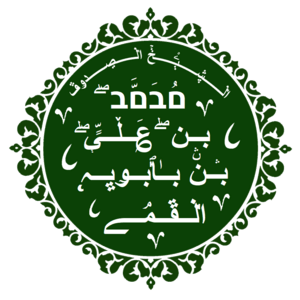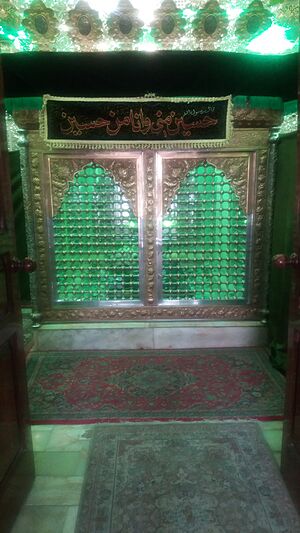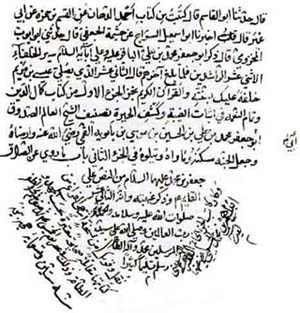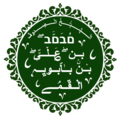Ibn Babawayh facts for kids
Quick facts for kids Muhammad ibn 'Ali ibn Babawaih al-Qummiمُحَمَّد ٱبْن عَلِيّ ٱبْن بَابَوَيْه ٱلْقُمِيّ |
|
|---|---|
 |
|
| Religion | Islam |
| Denomination | Shia |
| Personal | |
| Born | Muhammad c. 923 AD / 310 A.H. Qom |
| Died | 991 AD / 380 A.H. Rey |
| Senior posting | |
| Title | Al-Shaykh Al-Saduq ٱلشَّيْخ ٱلصَّدُوق |
| Influenced | Shaykh al-Mufid |
Muhammad ibn 'Ali ibn Babawayh al-Qummi (born around 923 AD, died 991 AD) was a very important Persian Shia Islamic scholar. People often called him Ibn Babawayh or al-Shaykh al-Saduq, which means "the truthful scholar."
He wrote a famous book called Man La Yahduruhu al-Faqih. This book is one of the four main collections of Hadith (sayings and actions of Prophet Muhammad and the Imams) for Shia Muslims.
Contents
Life of Al-Shaykh al-Saduq
The name Ibn Babawayh shows that his family came from Persia. His family had been strong followers of Shia Islam for a long time. His father, Ali ibn Babawayh Qummi, was a leading Islamic scholar in Qom.
Early Life and Education
We don't know the exact date Ibn Babawayh was born. Shia scholars believe it was around 918 AD. He grew up in Qom, a city in modern-day Iran. His father taught him, and he also learned from other local Shia scholars.
Qom was a major center for studying Shia traditions. Ibn Babawayh followed this type of religious learning throughout his life.
Travels and Teachings
In 966 AD, Ibn Babawayh left Qom and traveled to Baghdad. He journeyed widely, learning about Islamic traditions. He believed that understanding traditions was more important than just thinking about religious ideas.
Most of his books are collections of these traditions. However, he also wrote a book about the beliefs of Shia Islam called al-I'tiqadat. One of his students, al-Shaykh al-Mufid, later reviewed and updated this book.
Many Books
Ibn Babawayh was a very productive writer. Some scholars say he wrote over 300 books! However, many of these books are now lost. We still have some of his works, and others exist as old handwritten copies. His most famous book is Man la yahduruhu al-faqih.
Later Years and Passing
In his last years, al-Shaykh al-Saduq lived in Ray. He had been invited there by a ruler named Rukn al-Dawla. Even though he was treated well, his teaching was limited by a government official. This restriction seemed to affect many traditional scholars at that time.
Ibn Babawayh died in Ray in 991 AD. He was likely over 70 years old. He is buried in a place called Ebn-e Babooyeh in Iran.
Man La Yahduruhu al-Faqih
Man La Yahduruhu al-Faqih means "For Him Who is Not in the Presence of a Religious Scholar." It is one of the four most important books about Shia Islamic traditions. While Ibn Babawayh wrote many important works, this book is his most famous one that still exists.
Some experts believe there were actually five major books of traditions, including another of Ibn Babawayh's works called Madinat al-'ilm. This book might have been even bigger than Man la yahduruhu al-faqih, but it may no longer exist.
Why This Book Was Written
Man la yahduruhu al-faqih focuses on furu' (Islamic law and practices). The title suggests it's like "Every man his own lawyer."
Ibn Babawayh explained why he wrote the book. He met a respected person named Sharif al-Din Abu 'Abd Allah. This person had a book called "Every man his own doctor." He asked Ibn Babawayh to create a similar book for religious law. This new book would cover what is allowed and forbidden in Islam, and other religious rules.
Ibn Babawayh wanted this book to be a simple guide for everyday people. He didn't include the long chains of narrators (called Isnad) for each tradition. These chains are important for scholars to check if a tradition is real. But for a general guide, he wanted to keep it short and easy to use.
He said he wrote it so that "the book's advantages might be abundant." He only included traditions that he believed were correct and used in his own legal opinions.
What's Inside
In this book, Ibn Babawayh doesn't just list traditions. He also explains them. For example, when he talks about the pilgrimage, he describes all the steps Muslims should follow.
The book is organized into sections rather than chapters.
Where the Information Came From
Ibn Babawayh got his information from many sources. These included works by scholars who lived at the same time as important Imams like Ja'far al-Sadiq. He also used works from scholars who heard traditions directly from Imams Ali al-Rida, Muhammad al-Jawad, and al-Hadi.
He also used books from scholars like Muhammad ibn Yahya ibn 'Imran al-Ash'ari. His own father's writings were also a source. Ibn Babawayh even referred to his own earlier books.
Other Important Books
Ibn Babawayh wrote many other valuable books:
- Kamal al-din wa tamam al-ni'mah: This book is about the Mahdi, a leader Muslims believe will appear in the future. It discusses questions about the Mahdi's hidden period.
- Ma'ani al-Akhbar: This book helps explain difficult traditions and verses from the Quran.
- Oyoun Akhbar Al-Ridha: This book is dedicated to a government official and contains traditions from Imam Rida.
- Al-Khisal: This book teaches about good morals and explains their religious and historical reasons.
- Al-Amali: This is a collection of lectures given by Ibn Babawayh.
- Ilal al-shara'i: This book looks at the reasons behind Islamic rules and laws.
- Eʿteqādātal-Emāmīya: This book gives a clear summary of the main beliefs of Shia Islam.
Many of these books have been translated into other languages, like Urdu.
Images for kids




